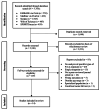Types of leisure-time physical activity participation in childhood and adolescence, and physical activity behaviours and health outcomes in adulthood: a systematic review
- PMID: 38965532
- PMCID: PMC11225122
- DOI: 10.1186/s12889-024-19050-3
Types of leisure-time physical activity participation in childhood and adolescence, and physical activity behaviours and health outcomes in adulthood: a systematic review
Abstract
Background: Youth leisure-time physical activity participation benefits physical activity habits and health outcomes later in life. However, it is unknown if certain types of leisure-time physical activity contribute to these benefits in different ways; this knowledge could enhance public health efforts. This systematic review aimed to synthesise evidence of the longitudinal associations between childhood and adolescent leisure-time physical activity on adulthood physical activity behaviours and health outcomes.
Methods: A systematic search of the literature was conducted across five databases from inception to July 2022. English, peer-reviewed observational studies with a minimum of two timepoints of data collection were eligible for inclusion. We included studies that investigated the association between participation in leisure-time physical activity types in children and adolescents (i.e., 5-18 years), and physical activity, mental health, or cardiovascular outcomes in adulthood (i.e., ≥ 18 years).
Results: Fourteen studies were included in the review, totalling 34,388 observations across five countries. Running in adolescence was associated with increased adulthood physical activity in both sexes, while sports involvement was associated with an increase in physical activity in males only. Adolescent team sports participation was associated with reduced odds of early adulthood depression, with varying findings for anxiety disorders. There was preliminary evidence of minimum threshold requirements for participation in certain activities before associations with future physical activity or health outcome benefits were observed.
Conclusions: Preliminary findings suggest that the lifelong behavioural and health benefits of adolescent participation in leisure-time physical activity appear to be related to the type of activity undertaken, with potential differences between sexes. With the rarity of longitudinal studies spanning from childhood into adulthood, these findings provide important insights for public health strategies to optimise lifelong health and physical activity participation.
Prospero registration: CRD42022347792.
Keywords: Adolescence; Cardiovascular Risk; Longitudinal; Mental Health; Physical activity; Preventive Health; Sports.
© 2024. The Author(s).
Conflict of interest statement
The authors declare no competing interests.
Figures
Similar articles
-
Leisure-time physical activity trajectories from adolescence to adulthood in relation to several activity domains: a 27-year longitudinal study.Int J Behav Nutr Phys Act. 2023 Mar 9;20(1):27. doi: 10.1186/s12966-023-01430-4. Int J Behav Nutr Phys Act. 2023. PMID: 36890586 Free PMC article.
-
Organized youth sport as a predictor of physical activity in adulthood.Scand J Med Sci Sports. 2009 Oct;19(5):646-54. doi: 10.1111/j.1600-0838.2008.00850.x. Epub 2008 Aug 5. Scand J Med Sci Sports. 2009. PMID: 18694430
-
Childhood and adolescent predictors of leisure time physical activity during the transition from adolescence to adulthood: a population based cohort study.Int J Behav Nutr Phys Act. 2011 Jun 1;8:54. doi: 10.1186/1479-5868-8-54. Int J Behav Nutr Phys Act. 2011. PMID: 21631921 Free PMC article.
-
Participation in sports in childhood and adolescence and physical activity in adulthood: A systematic review.J Sports Sci. 2019 Oct;37(19):2253-2262. doi: 10.1080/02640414.2019.1627696. Epub 2019 Jun 8. J Sports Sci. 2019. PMID: 31179841
-
Role of Physical Activity and Sedentary Behavior in the Mental Health of Preschoolers, Children and Adolescents: A Systematic Review and Meta-Analysis.Sports Med. 2019 Sep;49(9):1383-1410. doi: 10.1007/s40279-019-01099-5. Sports Med. 2019. PMID: 30993594
Cited by
-
Social epidemiology of sports and extracurricular activities in early adolescents.Pediatr Res. 2025 May 4:10.1038/s41390-025-04099-6. doi: 10.1038/s41390-025-04099-6. Online ahead of print. Pediatr Res. 2025. PMID: 40319141
-
Effects of substituting TV-watching time with physical activities or sleep on incident major depression. Results from the lifelines cohort study.Eur Psychiatry. 2025 May 30;68(1):e73. doi: 10.1192/j.eurpsy.2025.10045. Eur Psychiatry. 2025. PMID: 40443280 Free PMC article.
-
Resources used by young people to overcome mental distress in deprived settings in Latin America: a qualitative study.BMC Psychol. 2025 Jul 4;13(1):727. doi: 10.1186/s40359-025-02830-w. BMC Psychol. 2025. PMID: 40615934 Free PMC article.
-
Associations of sport and exercise participation in adolescence with body composition and device-measured physical activity in adulthood: longitudinal data from the Norwegian HUNT study.Int J Behav Nutr Phys Act. 2025 Mar 5;22(1):29. doi: 10.1186/s12966-025-01726-7. Int J Behav Nutr Phys Act. 2025. PMID: 40045311 Free PMC article.
-
Age-Related Variations in Clinical Profiles for Children with Sports- and Recreation-Related Concussions.Diagnostics (Basel). 2024 Sep 14;14(18):2042. doi: 10.3390/diagnostics14182042. Diagnostics (Basel). 2024. PMID: 39335720 Free PMC article.
References
-
- World Health Organisation. Global status report on physical activity 2022. Geneva; 2022.
-
- World Health Organisation . Global health risks: mortality and burden of disease attributable to selected major risks. Geneva: WHO; 2009.
Publication types
MeSH terms
Grants and funding
LinkOut - more resources
Full Text Sources
Medical


